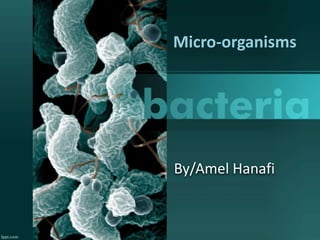Bacteria 2
•Download as PPTX, PDF•
0 likes•81 views
educational for grade 7
Report
Share
Report
Share

Recommended
More Related Content
What's hot
What's hot (20)
Class VIII Science: Chapter 2: Microorganisms; Friend and Foe

Class VIII Science: Chapter 2: Microorganisms; Friend and Foe
Economic importance of bacteria or application of bacteria

Economic importance of bacteria or application of bacteria
Similar to Bacteria 2
Similar to Bacteria 2 (20)
Biology - Chp 19 - Bacteria And Viruses - PowerPoint

Biology - Chp 19 - Bacteria And Viruses - PowerPoint
bacteria3.pptFirst discovered in extreme environments Methanogens: Harvest en...

bacteria3.pptFirst discovered in extreme environments Methanogens: Harvest en...
Microorganisms Friend OR foe- made by saksham gupta

Microorganisms Friend OR foe- made by saksham gupta
Gr 11 virusses,_bacteria,_protists_and_fungi_eng_only[1]![Gr 11 virusses,_bacteria,_protists_and_fungi_eng_only[1]](data:image/gif;base64,R0lGODlhAQABAIAAAAAAAP///yH5BAEAAAAALAAAAAABAAEAAAIBRAA7)
![Gr 11 virusses,_bacteria,_protists_and_fungi_eng_only[1]](data:image/gif;base64,R0lGODlhAQABAIAAAAAAAP///yH5BAEAAAAALAAAAAABAAEAAAIBRAA7)
Gr 11 virusses,_bacteria,_protists_and_fungi_eng_only[1]
Recently uploaded
Recently uploaded (20)
X-rays from a Central “Exhaust Vent” of the Galactic Center Chimney

X-rays from a Central “Exhaust Vent” of the Galactic Center Chimney
Vital Signs of Animals Presentation By Aftab Ahmed Rahimoon

Vital Signs of Animals Presentation By Aftab Ahmed Rahimoon
Mining Activity and Investment Opportunity in Myanmar.pptx

Mining Activity and Investment Opportunity in Myanmar.pptx
Vital Signs of Animals Presentation By Aftab Ahmed Rahimoon

Vital Signs of Animals Presentation By Aftab Ahmed Rahimoon
Information science research with large language models: between science and ...

Information science research with large language models: between science and ...
dkNET Webinar: The 4DN Data Portal - Data, Resources and Tools to Help Elucid...

dkNET Webinar: The 4DN Data Portal - Data, Resources and Tools to Help Elucid...
Soil and Water Conservation Engineering (SWCE) is a specialized field of stud...

Soil and Water Conservation Engineering (SWCE) is a specialized field of stud...
Adaptive Restore algorithm & importance Monte Carlo

Adaptive Restore algorithm & importance Monte Carlo
Harry Coumnas Thinks That Human Teleportation is Possible in Quantum Mechanic...

Harry Coumnas Thinks That Human Teleportation is Possible in Quantum Mechanic...
Manganese‐RichSandstonesasanIndicatorofAncientOxic LakeWaterConditionsinGale...

Manganese‐RichSandstonesasanIndicatorofAncientOxic LakeWaterConditionsinGale...
Bacteria 2
- 2. What are the traits of a prokaryotic cell? • Prokaryotic cell have no membrane bound organelles • Reproduce by binary fission • They are single celled organism • Most are smaller than Eukaryotic cell • cell parts: plasma memberane cytoplasm ribosomes DNA/RNA
- 3. How do bacteria breathe ? • Unlike human, bacteria have many ways to breathe • They are classified into: 1-aerobic bacteria using oxygen 2- anaerobic bacteria respire by the help of nitrates , sulphates and carbon dioxide NO OXYGEN
- 4. What do bacteria eat and take in food? • Take in food and obtain energy from breaking it down • Feed on dead organisms • Taking nutrients from living hosts • Make their own food(lot of light) • Use energy from chemical reactions like bacteria live in dark ocean floor
- 5. Where do bacteria live? • Bacteria are found every where in nature • They are found in soil ,air , animals and plants • On your body ,bacteria is found on your skin ,your mouth and your gut
- 6. Different ways bacteria is helpful to human • Bacteria help in digestion • In intestine bacteria makes vitamin K which help in blood clotting • Some bacteria prevent harmful bacteria from growing in your intestine • Bacteria help in manufacture of antibiotics • Bacteria help in making dairy products • Nitrogen fixation
- 7. How do bacteria move? • Bacteria move to find food resources • They move by 1- flagella and Pilli 2-twist as they move
- 8. How do bacteria reproduce? • Binary fission: cell division give 2 genetically identical cells , it takes ideal conditions20 minutes • Conjugation: it is not considered reproduction , it only cause genetic variation
- 10. Beneficial bacteria and harmful bacteria
- 12. How do bacteria keep the ecosystem healthy? • Bioremediation 1-bacteria can absorb the oil from accidental oil spill 2-eat pollution by breaking down harmful substance into less harmful substances
- 14. What are pathogenic bacteria? • Pathogens: agents that causes disease • Harmful bacteria that causes disease are few and considered pathogens • Some live normally in your body cause illness only in case when immune system weakened
- 15. What causes bacterial diseases? • Caused by • 1-damaging tissues ex: tuberculosis which invade lungs and breaks it down for food 2-producing toxins like that found in improperly canned food causing food poisoning ex: clostridium botulinum
- 16. Spreading and prevention How are bacteria spread • Bacteria can spread by getting contact with sick people • Touching food with dirty hands • People who cough and sneeze spread germs How are disease prevented • Disease can be prevented by washing hands • Cook and consume food quickly • pasteurization